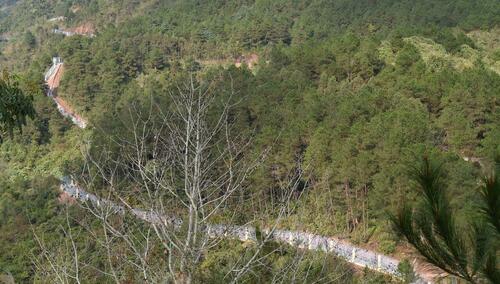CCP Builds “Southern Great Wall” To Seal Off Border And Stop COVID
As the CCP uses COVID as an excuse to ramp up its mass surveillance efforts in ways that many fear will remain in place long after the pandemic has faded, Beijing has started building what some are describing as another “Great Wall” across the southern border.
According to WSJ, major construction projects have sprung up in the small Chinese city of Ruili, situated in China’s far south near the border with Myanmar. Most of the construction appears focused on reinforcing a border fence equipped with barbed wire, surveillance cameras and sensors.
That should keep the COVID out…
Moving east, a 12-foot-high fence has been erected abruptly over the last year along China’s border with Vietnam. This wall has a very specific purpose: It stops Vietnamese locals from crossing the border into Chinese villages to harvest corn or sell medicinal herbs. It also gives the area the look of a prison, one local hotelier in Vietnam said.
Chinese citizens have taken to calling the new border fortifications “the southern Great Wall” while discussing it on Weibo and on other social media apps. But the authorities have been trying to push another name: “the anti-COVID Great Wall”.
Across the 3,000-mile-long border, the wall is causing serious disruptions to commerce and trade that are angering some of China’s neighbors (not that there’s anything they can do about it).
In an August letter to villagers in border areas of Yunnan province, Chinese leader Xi Jinping urged locals to “safeguard the sacred land” and unite with state workers to create an “impenetrable” border.
Elsewhere, party officials in Guangxi, another area bordering Vietnam, urged cadres to “race against time, go all out, resolutely win the battle against the pandemic and defend the ‘south gate'” of China.
Somehow, WSJ’s reporters managed to get their hands on records confirming that China has built or reinforced fencing across 285 miles of the southern border over the last two years. And given the nature of freedom of information laws in China, that picture is likely incomplete.
Commerce has been disrupted by the border walls, and the CCP’s paranoia about illegal border crossings has led them to press thousands of villagers into service as unpaid border guards doing volunteer shifts in addition to work.
And the process of getting cargo across the Myanmar border has also been made extremely tedious.
Trucks from Myanmar must stop at the Chinese border. Their cargoes have to be sanitized and remain on the Myanmar side for 48 hours. Then, robots and cranes move the cargo onto Chinese trucks. Chinese drivers take the goods across the border, where they are sanitized again and held for 24 more hours before they can be cleared for distribution inside China.
Although at the very least, authorities have started to actually allow cargo to cross the border again, something they didn’t do before.
“At least now we can restart our business,” said Chen Yunzhong, a 56-year-old businessman who imports fruits to China from Myanmar. “There was a period of time that I thought I had to do something else to make a living.”
But the biggest benefit of all is that, for years, Beijing has been trying to tame China’s border with Myanmar because it’s a hot spot for smuggling and drug trafficking.
Now, COVID has provided them the opportunity to make it happen. As one academic quoted by WSJ put it: “COVID might be the official justification that China is giving for building the buffer zone now,” he said. “But that intention started long before and will govern things long after the pandemic ends.”
Tyler Durden
Fri, 02/04/2022 – 21:20
via ZeroHedge News https://ift.tt/AItmMYP Tyler Durden
